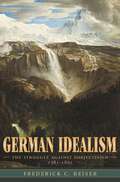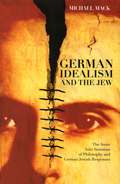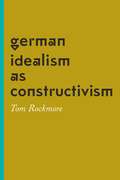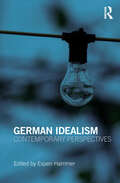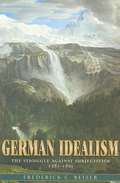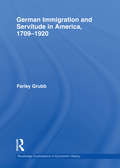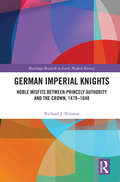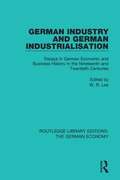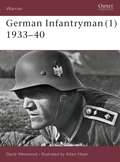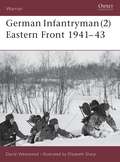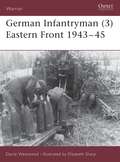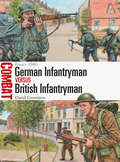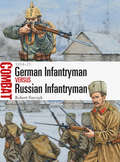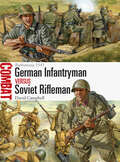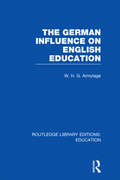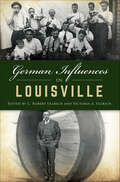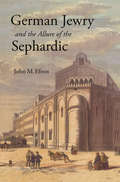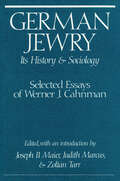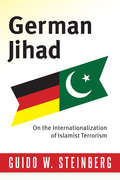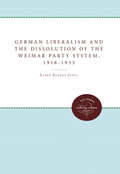- Table View
- List View
German Idealism
by Frederick C. BeiserOne of the very few accounts in English of German idealism, this ambitious work advances and revises our understanding of both the history and the thought of the classical period of German philosophy. As he traces the structure and evolution of idealism as a doctrine, Frederick Beiser exposes a strong objective, or realist, strain running from Kant to Hegel and identifies the crucial role of the early romantics--Hölderlin, Schlegel, and Novalis--as the founders of absolute idealism. Traditionally, German idealism is understood as a radical form of subjectivism that expands the powers of the self to encompass the entire world. But Beiser reveals a different--in fact, opposite--impulse: an attempt to limit the powers of the subject. Between Kant and Hegel he finds a movement away from cosmic subjectivity and toward greater realism and naturalism, with one form of idealism succeeding another as each proved an inadequate basis for explaining the reality of the external world and the place of the self in nature. Thus German idealism emerges here not as a radical development of the Cartesian tradition of philosophy, but as the first important break with that tradition.Table of Contents: Introduction 1. Realism in German Idealism 2. Exorcising the Spirit 3. The Critique of Foundationalism 4. The Troublesome Hegelian Legacy 5. The Taxonomy of German Idealism I. KANT'S CRITIQUE OF IDEALISM Introduction: Kant and the Problem of Subjectivism 1. The Clash of Interpretations 2. Method and Results 3. Contemporary Kant Scholarship 1. Idealism in the Precritical Years 1. The Idealist Challenge 2. The First Refutation of Idealism 3. Idealist Dreams and Visions 4. The Critique of Idealism in the Inaugural Dissertation 5. Skeptical Ambivalence 6. David Hume, Transcendental Realist 2. Transcendental Idealism and Empirical Realism 1. The Case for Subjectivism 2. The First Edition Definitions of Transcendental Idealism 3. Transcendental versus Empirical Idealism 4. Empirical Realism in the Aesthetic 5. Empirical Realism and Empirical Dualism 3. The First Edition Refutation of Skeptical Idealism 1. The Priority of Skeptical Idealism 2. The Critique of the Fourth Paralogism 3. The Proof of the External World 4. A Cartesian Reply 5. Appearances and Spatiality 6. The Ambiguity of Transcendental Idealism 7. The Coherence of Transcendental Idealism 4. The First Edition Refutation of Dogmatic Idealism 1. The Missing Refutation 2. Kant's Interpretation of Leibniz 3. The Dispute in the Aesthetic 4. Dogmatic Idealism in the Antinomies 5. Kant and Berkeley 1. The Göttingen Review 2. Kant's Reaction 3. Berkeleyianism in the First Edition of the Kritik 4. The Argument of the Prolegomena 5. Kant's Interpretation of Berkeley 6. The Small but Real Differences? 6. The Second Edition Refutation of Problematic Idealism 1. The Problem of Interpretation 2. Kant's Motives 3. The Question of Kant's Realism 4. Realism in the Refutation 5. The New Strategy 6. The Argument of the Refutation 7. Outer vis-à-vis Inner Sense 8. Kant's Refutations in the Reflexionen, 1788-93 7. Kant and the Way of Ideas 1. The Theory of Ideas 2. Loyalty and Apostasy 3. The Transcendental versus the Subjective 4. The Question of Consistency 5. The Doctrine of Inner Sense 6. Kantian Self-Knowledge and the Cartesian Tradition 8. The Transcendental Subject 1. Persistent Subjectivism 2. Eliminating the Transcendental Subject 3. The Criteria of Subjectivity 4. The Subjectivity of the Transcendental 5. Restoring the Transcendental Subject 9. The Status of the Transcendental 1. The Problematic Status of the Categories 2. The Metaphysial Interpretation 3. The Psychological Interpretation 4. The Logical Interpretation 5. The Ineliminable Psychological Dimension 6. Problems of Transcendental Psychology 7. Transcendental Psychology and Transcendental Idealism 10. Kant's Idealism in the Opus postumum 1. Kant's Peruke 2. The Gap in the Critical System 3. The Transition Program and Its Implications 4. The Transition and Refutation 5. The Selbstsetzungslehre 6. Appearance of Appe...
German Idealism and the Concept of Punishment
by Joseph J. Kominkiewicz Frances BrownAgainst the background of early modernism - a period that justified punishment by general deterrence - Kant is usually thought to represent a radical turn towards retributivism. For Kant, and later for Fichte and Hegel, a just punishment respects the humanity inherent in the criminal, and serves no external ends - it is instituted only because the criminal deserves it. In this original study, Jean-Christophe Merle uses close analysis of texts to show that these philosophers did not in fact hold a retributivist position, or even a mixed position; instead he traces in their work the gradual emergence of views in favour of deterrence and resocialisation. He also examines Nietzsche's view that morality rests on the rejection of retribution. His final chapter offers a challenge to the retributivist position, and a defence of resocialisation, in the context of current legal theory and practice concerning the punishment of crimes against humanity.
German Idealism and the Jew: The Inner Anti-Semitism of Philosophy and German Jewish Responses
by Michael MackIn German Idealism and the Jew, Michael Mack uncovers the deep roots of anti-Semitism in the German philosophical tradition. While many have read German anti-Semitism as a reaction against Enlightenment philosophy, Mack instead contends that the redefinition of the Jews as irrational, oriental Others forms the very cornerstone of German idealism, including Kant's conception of universal reason. Offering the first analytical account of the connection between anti-Semitism and philosophy, Mack begins his exploration by showing how the fundamental thinkers in the German idealist tradition—Kant, Hegel, and, through them, Feuerbach and Wagner—argued that the human world should perform and enact the promises held out by a conception of an otherworldly heaven. But their respective philosophies all ran aground on the belief that the worldly proved incapable of transforming itself into this otherworldly ideal. To reconcile this incommensurability, Mack argues, philosophers created a construction of Jews as symbolic of the "worldliness" that hindered the development of a body politic and that served as a foil to Kantian autonomy and rationality. In the second part, Mack examines how Moses Mendelssohn, Heinrich Heine, Franz Rosenzweig, and Freud, among others, grappled with being both German and Jewish. Each thinker accepted the philosophies of Kant and Hegel, in varying degrees, while simultaneously critiquing anti-Semitism in order to develop the modern Jewish notion of what it meant to be enlightened—a concept that differed substantially from that of Kant, Hegel, Feuerbach, and Wagner. By speaking the unspoken in German philosophy, this book profoundly reshapes our understanding of it.
German Idealism as Constructivism
by Tom RockmoreGerman Idealism as Constructivism is the culmination of many years of research by distinguished philosopher Tom Rockmore—it is his definitive statement on the debate about German idealism between proponents of representationalism and those of constructivism that still plagues our grasp of the history of German idealism and the whole epistemological project today. Rockmore argues that German idealism—which includes iconic thinkers such as Kant, Fichte, Schelling, and Hegel—can best be understood as a constructivist project, one that asserts that we cannot know the mind-independent world as it is but only our own mental construction of it. Since ancient Greece philosophers have tried to know the world in itself, an effort that Kant believed had failed. His alternative strategy—which came to be known as the Copernican revolution—was that the world as we experience and know it depends on the mind. Rockmore shows that this project was central to Kant’s critical philosophy and the later German idealists who would follow him. He traces the different ways philosophers like Fichte, Schelling, and Hegel formulated their own versions of constructivism. Offering a sweeping but deeply attuned analysis of a crucial part of the legacy of German idealism, Rockmore reinvigorates this school of philosophy and opens up promising new avenues for its study.
German Idealism: Contemporary Perspectives
by Espen HammerThis outstanding collection of specially commissioned chapters examines German idealism from several angles and assesses the renewed interest in the subject from a wide range of fields. Including discussions of the key representatives of German idealism such as Kant, Fichte and Hegel, it is structured in clear sections dealing with: metaphysics the legacy of Hegel’s philosophy Brandom and Hegel recognition and agency autonomy and nature the philosophy of German romanticism. Amongst other important topics, German Idealism: Historical and Philosophical Perspectives addresses the debates surrounding the metaphysical and epistemological legacy of German idealism; its importance for understanding recent debates in moral and political thought; its appropriation in recent theories of language and the relationship between mind and world; and how German idealism affected subsequent movements such as romanticism, pragmatism, and critical theory. Contributors: Espen Hammer, Stephen Houlgate, Sebastian Gardner, Paul Redding, Andrew Bowie, Richard Eldridge, Jay Bernstein, Frederick Beiser, Paul Franks, Robert Pippin, Fred Rush, Manfred Frank, Terry Pinkard, Robert Stern
German Idealism: The Struggle against Subjectivism 1781-1801
by Frederick C. BeiserThis work advances and revises our understanding of both the history and the thought of the classical period of German philosophy.
German Immigrants, Race, and Citizenship in the Civil War Era
by Alison Clark EffordThis study of Civil War-era politics explores how German immigrants influenced the rise and fall of white commitment to African-American rights. Intertwining developments in Europe and North America, Alison Clark Efford describes how the presence of naturalized citizens affected the status of former slaves and identifies 1870 as a crucial turning point. That year, the Franco-Prussian War prompted German immigrants to reevaluate the liberal nationalism underpinning African-American suffrage. Throughout the period, the newcomers' approach to race, ethnicity, gender, and political economy shaped American citizenship law.
German Immigration and Servitude in America, 1709-1920 (Routledge Explorations In Economic History Ser. #53)
by Farley GrubbThis book provides the most comprehensive history of German migration to North America for the period 1709 to 1920 than has been done before. Employing state-of-the-art methodological and statistical techniques, the book has two objectives. First he explores how the recruitment and shipping markets for immigrants were set up, determining what the voyage was like in terms of the health outcomes for the passengers, and identifying the characteristics of the immigrants in terms of family, age, and occupational compositions and educational attainments. Secondly he details how immigrant servitude worked, by identifying how important it was to passenger financing, how shippers profited from carrying immigrant servants, how the labor auction treated immigrant servants, and when and why this method of financing passage to America came to an end.
German Imperial Knights: Noble Misfits Between Princely Authority and the Crown, 1479-1648
by Richard J. NinnessThe German imperial knights were branded disobedient, criminal, or treasonous, but instead of finding themselves on the wrong side of history, they resisted marginalization and adapted through a combination of conservative and progressive strategies. The knights tried to turn the elite world on its head through their constant challenges to the princes in the realms of both culture and governance. They held their own chivalric tournaments from 1479-1487, and defied the emperor and powerful princes in refusing to obey laws that violated custom. But their resistance led to a series of disasters in the 1520s: their leaders were hunted down and their castles destroyed. Having failed on their own, they turned to Emperor Charles V in the 1540s and the imperial knighthood was formed. This new status stabilized their position and provided them with important rights, including the choice between Lutheranism and Catholicism. During the Reformation era (1517-1648), no other German group embraced diversity in religion like the imperial knights. Despite the popularity of Protestantism in the group, they stood up to their princely adversaries, now Protestant, becoming champions of the Catholic Church and proved themselves just as staunch defenders of the Church as the Habsburg and Wittelsbach dynasties.
German Industry and German Industrialisation: Essays in German Economic and Business History in the Nineteenth and Twentieth Centuries (Routledge Library Editions: The German Economy #9)
by W. R. LeeOriginally published in 1991 this book brings together 9 essays which address a number of central issues relating to the nature of German industrialisation, including the role of foreign competition in fostering technological change, the importance of market integration for economic development and the response of German banks to industrialisation. The book also provides an important corrective to the traditional interpretation of German industrialisation and reassesses the economic impact of the customs union (Zollverein). The reappraisal of some dominant themes in German economic and business history is distinctive in its explicit use of economic theory in historical analysis of long-term growth processes. It also emphasises the importance of sectoral analysis and illustrates the usefulness of a differential regional approach for understanding the process of German industrialisation.
German Infantryman (1) 1933-40
by Adam Hook David WestwoodThe common German infantryman played a crucial role in the events that led to the outbreak of World War II (1939-1945), and the burden of duty lay on his shoulders during the opening moves of the conflict, in the invasion of Poland, the conquest of Norway and Denmark, the Low Countries and France. The Wehrmacht was unstoppable in this period, as it defeated almost every country that took the field against it. This volume examines the recruitment, training, weapons and equipment of the German infantryman in the eventful years building up to and including Blitzkrieg. Weaponry, team roles, tactics, training and personal equipment are all covered.
German Infantryman (2) Eastern Front 1941-43
by David WestwoodIn this second volume examining the German infantryman before and during World War 2, post-1941 training, weapons, equipment, combat experiences and medical care are examined. The 'faceless' German soldier who struggled through bitter fighting up to and including Stalingrad retains his identity both as a human being and as a vital part of the Wehrmacht's order of battle. Containing a full array of previously unpublished photographs taken by German soldiers during the invasion of Russia this book shows in superb detail daily life and duties, the soldiers themselves, and combat action.
German Infantryman (3) Eastern Front 1943-45
by David WestwoodThis third volume of a successful mini-series examines the German Infantryman in the latter part of World War II. Despite being constantly in retreat, often short of equipment, sometimes hungry, cold and wet, and the overwhelming numbers of Soviet troops and armour facing him, the German Infantryman’s resistance was always fierce, and although constantly moving back towards Germany, his defensive withdrawals cost the Russians dearly. During this period defensive tactics involved close artillery and tank cooperation, even at small unit level. Containing previously unpublished photographs and poignant first hand accounts, this book explores in superb detail daily life, duties and combat action.
German Infantryman vs British Infantryman - France 1940
by Adam Hook David GreentreeWhen Hitler's forces poured into France and the Low Countries in 1940, the uneasy peace of the 'Phoney War' was shattered, and Europe was ripped apart by another Blitzkrieg. Forming the backbone of the German advance were the mobile, well-equipped Schützen (Rifles), motorized infantry who embodied the essence of the fluid, swift warfare that had characterized World War II thus far. Facing them were infantrymen of the British Expeditionary Force, units of considerable fighting quality who had nevertheless had no special training or doctrinal instruction to conduct combined-arms warfare in conjunction with armor.This study investigates the clash between the two adversaries at small-unit level, recreating the ferocity of the fighting on the front lines of the Battle of France. It assesses the training, organization and unit ethos of both sides in the context of a new type of mobile warfare, and reveals the extraordinary difficulties encountered by infantry units in trying to remain in contact with their armored and mechanized formations. Drawing on first-hand combat reports and iluminative illustrations, it focuses on three key clashes at Arras, Calais and Merville and goes onto explore the important lessons learned by both sides about the nature of combined-arms warfare.
German Infantryman vs Russian Infantryman: 1914-15
by Robert Forczyk Adam HookThe Eastern Front of World War I is sometimes overshadowed by the fighting in the West. But the clashes between Imperial Germany and Tsarist Russia in East Prussia, Poland and Lithuania were every bit as gruelling for the participants as the great battles in Western Europe. In spite of the crushing German victory at Tannenburg in August 1914, the war in the East would grind on for two more years. Featuring full-color artwork, specially drawn maps and archive photographs, this study assesses the tactics, leadership and combat performance of German and Russian footsoldiers fighting in battles at Gumbinnen, Göritten and Mahartse, revealing the evolving nature of infantry warfare on the Eastern Front during World War I.
German Infantryman vs Soviet Rifleman
by David CampbellFeaturing full-color artwork, specially drawn maps and archive photographs, this study offers key insights into the tactics, leadership, combat performance and subsequent reputations of six representative German and Soviet infantry battalions pitched into three pivotal actions that determined the course of the Barbarossa campaign at the height of World War II.The Axis invasion of the Soviet Union on 22 June 1941 pitted Nazi Germany and her allies against Stalin's forces in a mighty struggle for survival. Three German army groups - North, Center and South - advanced into Soviet-held territory; Generalfeldmarschall Fedor von Bock's Army Group Center, the largest of these three, was tasked with defeating General of the Army Dmitry Pavlov's Western Front in Belarus, and was assigned two Panzer Groups to achieve this. Bock's command would complete the encirclement and destruction of vast numbers of Soviet personnel and matériel at battles such as Białystok-Minsk in June-July and Smolensk in July-August before being halted as German efforts centered on the conquest of the Ukraine, only to resume the offensive at the end of September. As the dust of summer gave way to the mud of autumn, the ensuing German drive on Moscow was slowed and then halted by a Soviet counteroffensive mounted by Konev's Kalinin and Timoshenko's Southwestern Fronts in December amid unusually harsh winter conditions, marking the failure of the German Blitzkrieg; Army Group Centre was forced back and Moscow remained in Soviet hands.At the forefront of the German advance, fighting alongside the spearhead Panzer divisions, were the lorry-borne infantrymen of the motorized infantry divisions. Unlike the Schützen, the specialist armored infantry integral to the Panzer divisions, these highly trained motorized formations were organized, armed and equipped as per their footslogging counterparts in the standard infantry divisions; together, these two troop types were the forerunners of the formidable Panzergrenadier formations that would provide the Germans with their mobile infantry forces in the climactic years of World War II.Opposing the German mobile forces, the Soviets deployed rifle divisions and motorized rifle divisions, some of which would be upgraded to Guards status following outstanding combat performance. The Soviet forces fought tenaciously in the teeth of sometimes overwhelming local German superiority and with the threat of savage reprisals from the NKVD troops at their backs, suffering huge losses but remaining in the fight until the lines could be stabilized in the worsening winter conditions outside Moscow. Their clashes with the motorized infantrymen of the German vanguard would shape the outcome of this mighty battle for survival.
German Influence on English Education (Routledge Library Editions: Education)
by W H ArmytageThis book traces the impact of German educationists, such as Froebel and Herbart, on practice in Britain while stressing the important and lasting influence of German scientists, technologists, philosophers, sociologists and historians on our educational system. This record of interplay between the two countries shows not only the influence of German innovations but also the effect on British education of the many German émigrés in the last two hundred years.
German Influences in Louisville (American Heritage)
by C. Robert UllrichThe first German immigrants in Louisville were shoemakers, bakers, butchers, blacksmiths and brewers--literally everything from basket makers to carriage manufacturers. Later, these industrious immigrants became captains of industry and influence in the city. August Prante's family built many of the magnificent organs for Louisville churches. Abraham Flexner was a pioneer in medical education, while Louis Brandeis was the first Jew to serve on the United States Supreme Court. William George Stuber, the son of Louisville photographer Michael Stuber, became the president of the Eastman Kodak Company. C. Robert Ullrich and Victoria A. Ullrich present a series of essays detailing how German immigrants shaped the industry and culture of Louisville.
German Intellectuals and the Challenge of Democratic Renewal
by Sean A. FornerThis book examines how democracy was rethought in Germany in the wake of National Socialism, the Second World War and the Holocaust. Focusing on a diverse network of public intellectuals in the immediate post-war occupation years, Sean A. Forner traces their attempts to reckon with the experience of Nazism and scour Germany's ambivalent political and cultural traditions for materials with which to build a better future. In doing so, he reveals, they formulated an internally variegated but distinctly participatory vision of democratic renewal - a paradoxical counter-elitism of intellectual elites. Although their projects ran aground on internal tensions and on the Cold War, their commitments fuelled critique and dissent in East and West during the 1950s and thereafter. The book uncovers a conception of political participation that went beyond the limited possibilities of the Cold War era and which would influence the political struggles of later decades in both post-war Germanys.
German Jewry and the Allure of the Sephardic
by John M. EfronIn the eighteenth and nineteenth centuries, as German Jews struggled for legal emancipation and social acceptance, they also embarked on a program of cultural renewal, two key dimensions of which were distancing themselves from their fellow Ashkenazim in Poland and giving a special place to the Sephardim of medieval Spain. Where they saw Ashkenazic Jewry as insular and backward, a result of Christian persecution, they depicted the Sephardim as worldly, morally and intellectually superior, and beautiful, products of the tolerant Muslim environment in which they lived. In this elegantly written book, John Efron looks in depth at the special allure Sephardic aesthetics held for German Jewry.Efron examines how German Jews idealized the sound of Sephardic Hebrew and the Sephardim's physical and moral beauty, and shows how the allure of the Sephardic found expression in neo-Moorish synagogue architecture, historical novels, and romanticized depictions of Sephardic history. He argues that the shapers of German-Jewish culture imagined medieval Iberian Jewry as an exemplary Jewish community, bound by tradition yet fully at home in the dominant culture of Muslim Spain. Efron argues that the myth of Sephardic superiority was actually an expression of withering self-critique by German Jews who, by seeking to transform Ashkenazic culture and win the acceptance of German society, hoped to enter their own golden age.Stimulating and provocative, this book demonstrates how the goal of this aesthetic self-refashioning was not assimilation but rather the creation of a new form of German-Jewish identity inspired by Sephardic beauty.
German Jewry: Its History and Sociology
by Joseph B. MaierThis history of post-Emancipation German Jewry and of the Holocaust aftermath has received considerable scholarly attention. The study of Jewish life in Germany in the 1930s and the migration impelled by the Nazi period has, on the other hand, been comparatively neglected. The work of Werner J. Cahnman (1902-1980) goes a long way toward filling this gap.Cahnman's examination of "the Jewish people that dwells among the nations" is focused on Germany because it was the country "where in modern times the symbiosis . . . has been most intimate and it also has been the country where the conflict degenerated into the monstrosity of the Holocaust." This representative anthology of his essays shares a common theme, although the examples differ in thought, method and style. Whether he explores the stratification of pre-Emancipation German Jewry, the rise of the Jewish national movement in Austria, or such an esoteric topic as the influence of the kabbalistic tradition on German idealist philosophy; whether he muses on the writing of Jewish history or reports on his firsthand experience in Dachau, Cahnman's work reflects central concerns of his personal and scholarly existence as a German Jew. Because he usually combined extensive empirical data with his own background and personal experience, he is able to craft a penetrating analysis of the recent history of Jewish life in Central Europe. Werner Cahnman believed that the "writing of history is vital for the continued cultural identity of the human kind."
German Jews in Love: A History (Stanford Studies in Jewish History and Culture)
by Christian BaileyThis book explores the dynamic role of love in German-Jewish lives, from the birth of the German Empire in the 1870s, to the 1970s, a generation after the Shoah. During a remarkably turbulent hundred-year period when German Jews experienced five political regimes, rapid urbanization, transformations in gender relations, and war and genocide, the romantic ideals of falling in love and marrying for love helped German Jews to develop a new sense of self. Appeals to romantic love were also significant in justifying relationships between Jews and non-Jews, even when those unions created conflict within and between communities. By incorporating novel approaches from the history of emotions and life-cycle history, Christian Bailey moves beyond existing research into the sexual and racial politics of modern Germany and approaches a new frontier in the study of subjectivity and the self. German Jews in Love draws on a rich array of sources, from newspapers and love letters to state and other official records. Calling on this evidence, Bailey shows the ways German Jews' romantic relationships reveal an aspect of acculturation that has been overlooked: how deeply cultural scripts worked their way into emotions; those most intimate and seemingly pre-political aspects of German-Jewish subjectivity.
German Jihad: On the Internationalization of Islamist Terrorism
by Guido W. SteinbergSince 2007, the German jihadist scene has become Europe’s most dynamic, characterized by an extreme anti-Americanism, impressive international networks, and spectacular propaganda. German jihadists travel to Turkey, Chechnya, Pakistan, and Afghanistan, trading in jihadist ideologies and allying themselves with virulent organizations. Mapping the complicated interplay between jihadists’ personal motivations and the goals and strategies of the world’s major terrorist groups, Guido Steinberg provides the first analysis of German jihadism, its links to Turkey, and its growing, global operational importance. Steinberg follows the formation of German-born militant networks in German cities and their radicalization and recruitment. He describes how these groups join up with al-Qaeda-affiliated organizations in Afghanistan and Pakistan, such as the Islamic Jihad Union, the Islamic Movement of Uzbekistan, and the Taliban, and he plots the path that directly involves them in terrorist activities. Situating these developments within a wider global context, Steinberg interprets the expanding German scene as part of a greater internationalization of jihadist ideology and strategy, swelling the movement’s membership since 9/11. Increasing numbers of Pakistanis, Afghans, Turks, Kurds, and European converts have come to the aid of Arab al-Qaeda, an incremental integration that has worrisome implications for the national security of Germany, the United States, and their allies.
German Late War Armored Fighting Vehicles: World War II AFV Plans (AFV Plans)
by George BradfordFor modelers and WWIl enthusiasts, a collection of scale drawings of German combat vehicles. For armor modeling and military vehicle enthusiasts, this volume is filled with fine-scale drawings of Germany&’s late war armored vehicles including: • Pz. Kpfw. V Panther Tank • Pz. Kpfw. VI Tiger I and II • Pz. Jager Elephant Tank Destroyer • Sd.Kfz. 234/2 &“Puma&” Armored Car • Jagdtiger with Henschel suspension • And dozens more . . .
German Liberalism and the Dissolution of the Weimar Party System, 1918-1933
by Larry Eugene JonesJones offers a detailed and comprehensive overview of the development and decline of the German Democratic party and the German People's party from 1918 to 1933. In tracing the impact of World War I, the runaway inflation to the 1920s, and the Great Depression of the 1930s upon Germany's middle-class electorate, the study demonstrates why the forces of liberalism were ineffective in preventing the rise of nazism and the establishment of the Third Reich.Originally published in 1988.A UNC Press Enduring Edition -- UNC Press Enduring Editions use the latest in digital technology to make available again books from our distinguished backlist that were previously out of print. These editions are published unaltered from the original, and are presented in affordable paperback formats, bringing readers both historical and cultural value.
